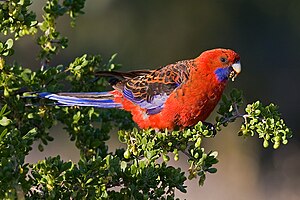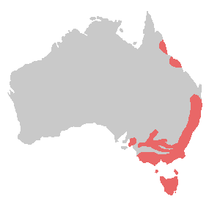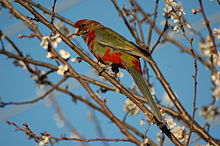Pennant Parakeet
| Pennant Parakeet | ||||||||||
|---|---|---|---|---|---|---|---|---|---|---|

Pennant Parakeet ( Platycercus elegans ), male |
||||||||||
| Systematics | ||||||||||
|
||||||||||
| Scientific name | ||||||||||
| Platycercus elegans | ||||||||||
| ( Gmelin , 1788) |
The Pennant parakeet ( Platycercus elegans ) is a bird art from the family of authentics Parrots (Psittacidae).
Some authors also place the very similar Adelaide Parakeet ( Platycercus adelaidae ), sometimes even the predominantly straw-yellow straw parakeet ( Platycercus flaveolus ) as subspecies of the Pennant Parakeet.
Appearance
Pennant Parakeets are long-tailed parrots with a body length of up to 36 centimeters and 110 to 170 grams in weight. Males are slightly larger than females. All three subspecies are predominantly scarlet, with blue cheek spots and tail feathers, black wings with blue outer flags and light blue wing leading edges. The plumage on the shoulders and upper back is black with red feather edges. The upper bill is light whitish to yellowish, the lower bill is darker gray.
In the Greater Pennant Parakeet ( P. e. Elegans ), the young birds are initially predominantly green feathered, with red coloring only on the lower abdomen, upper chest and forehead and blue coloring in the same places as in adults. You only get the adult dress after about 14 months.
The dark red little Pennant Parakeet ( P. e. Nigrescens ) is significantly smaller at 110 to 120 grams. Its fledglings are red from the start.
As a third subspecies, the North Pennant Parakeet ( P. e. Melanoptera ) can be distinguished, which appears darker due to narrower red feathers on the back. Incidentally, it is very similar to the Greater Parakeet.
Numerous varieties of color were bred out in captivity.
distribution
The species occurs in the precipitation-rich areas in eastern Australia . The Great Pennant Parakeet inhabits the most southeastern Queensland , the east of New South Wales , Victoria and the southeastern tip of South Australia . There are naturalized occurrences in New Zealand and on Norfolk Island north of it. The Little Pennant Parakeet lives further north in an area near the coast in east Queensland between Cooktown north of Cairns and Mackay . The North Pennant Parakeet has the smallest range. It only occurs on Kangaroo Island off the coast of South Australia.
According to the IUCN, the Pennant Parakeet is common and not endangered.
habitat
The Pennant Parakeet lives in relatively moist forests, such as coastal mountain forests, up to an altitude of 2000 meters. But he also visits forest edges, open woodland and even cultivated land and parks in the cities.
Diet and Lifestyle
The birds live in pairs or small groups, only young birds join together to form larger flocks. They are quite local, only in winter the birds nomad in a wider area. Their flight is wavy and they usually only fly at a low altitude.
Pennant Parakeets look for food both on the ground and in trees . They feed mainly on seeds and fruits , for example they often use stone and pome fruit in orchards . Especially large they also eat insects larvae . Depending on the season, this can make up half of the daily amount of food.
In human care, the birds can live to be 20 to 25 years old - rarely over 30 years.
voice
The voice is rated differently, the opinions range from "is quite pleasant and not very loud" to "unbearable and unbearable indoors". While foraging for food, they give off a quiet chirping. Only the alarm call, a metallic "kwiik-kwiik", is a little louder. The voice resembles that of the magnificent rosella .
Reproduction
The breeding season takes place from September to January. During courtship , the male sits next to the female with slightly opened wings, sways the fanned tail back and forth and gives off a constant chatter.
Pennant Parakeets breed in tree hollows. The female incubates three to eight eggs alone for almost three weeks and is fed by the male outside the brood cavity during this time. In the first few days after hatching, the female feeds the young alone, later the male also participates. After about five weeks, the young birds fledge.
More information
The Pennant Parakeet is a popular pet - probably because of its striking color . However, it should always be kept in pairs and in a sufficiently large aviary (at least 6 meters in length). Since it is quite robust and very weatherproof, it is also suitable for beginners in bird keeping.
Subspecies
There are seven known subspecies:
- Platycercus elegans nigrescens E. P. Ramsay , 1888 - The subspecies occurs in northeast Queensland .
- Platycercus elegans filewoodi McAllan & Bruce , 1989 - This subspecies is common in east-central Queensland.
- Platycercus elegans elegans ( JF Gmelin , 1788) - The nominate form occurs from south-east Queensland to south-east South Australia .
- Platycercus elegans melanopterus North , 1906 - This subspecies is common on Kangaroo Island .
- Platycercus elegans fleurieuensis Ashby , 1917 - This subspecies is common in the mountain range around Mount Lofty in the state of South Australia.
- Platycercus elegans subadelaidae Mathews , 1912 - This subspecies is common in the Flinders Range in South Australia.
- Platycercus elegans flaveolus Gould , 1837 - This subspecies is distributed along the Murray River in southeast Australia.
supporting documents
Individual evidence
- ^ Forshaw, p. 436.
- ^ IOC World Bird List New Zealand parrots, cockatoos & parrots
- ^ Edward Pierson Ramsay, p. 42.
- ↑ Ian Arthur William McAllan et al. a., p. 44.
- ^ Johann Friedrich Gmelin, p. 318.
- ^ Alfred John North, p. 78.
- ^ Edwin Ashby, p. 44.
- ^ Gregory Macalister Mathews, p. 270.
- ^ John Gould, Plate 23, Figure 1, & text.
literature
- Joseph M. Forshaw : Australian Parrots. 1st German-language edition. Volume 2, Arndt-Verlag, Bretten 2003, ISBN 3-9808245-2-7 .
- Johann Friedrich Gmelin: Systema Naturae per Regna Tria Naturae, Secundum Classes, Ordines, Genera, Species, Cum Characteribus, Differentiis, Synonymis, Locis. tape 1 , no. 1 . Georg Emanuel Beer, Leipzig 1788 ( [1] [accessed February 23, 2015]).
- John Gould: A synopsis of the birds of Australia, and the adjacent Islands . 2, plate 23, figure 1, & text. Published the Author, London 1837 ( online [accessed 23 February 2015]).
- Edward Pierson Ramsay: Tabular list of all the Australian birds at present known to the author, showing the distribution of the species over the continent of Australia and adjacent islands . Published the Author, Sydney 1888.
- Gregory Macalister Mathews: A Reference-List to the Birds of Australia . In: Novitates Zoologicae . tape 18 , no. 3 , 1912, pp. 171-446 ( online [accessed February 23, 2015]).
- Alfred John North: Kangaroo Islands Birds . In: The Emu . tape 6 , 1912, pp. 77-79 ( online [accessed February 23, 2015]).
- Edwin Ashby: Supplementary Notes on the Fleurieu Peninsula Rosella, and Comments on the Affinities of Platycercus adelaidae (Gould) and P. flaveolus (Gould) . In: The Emu . tape 17 , 1917, pp. 44–45 ( online [accessed February 23, 2015]).
- Ian Arthur William McAllan, Murray Duncan Bruce: The Birds of New South Wales A Working List . Biocon Research Group, Turramurra, New South Wales 1989.
Web links
- Platycercus elegans in the endangered Red List species the IUCN 2008. Posted by: BirdLife International, 2008. Accessed January 2 of 2009.
- BirdLife International: Species Factsheet - Crimson Rosella ( Platycercus elegans ) . Retrieved February 23, 2015.
- Videos, photos and sound recordings of Crimson Rosella (Platycercus elegans) in the Internet Bird Collection
- Amethyst star hummingbird ( Platycercus elegans ) at Avibase; accessed on February 23, 2015.
- Platycercus elegans in the Integrated Taxonomic Information System (ITIS)
- xeno-canto: Sound recordings - Crimson Rosella ( Platycercus elegans )
- Pennant Parakeet at sittich-info.de


